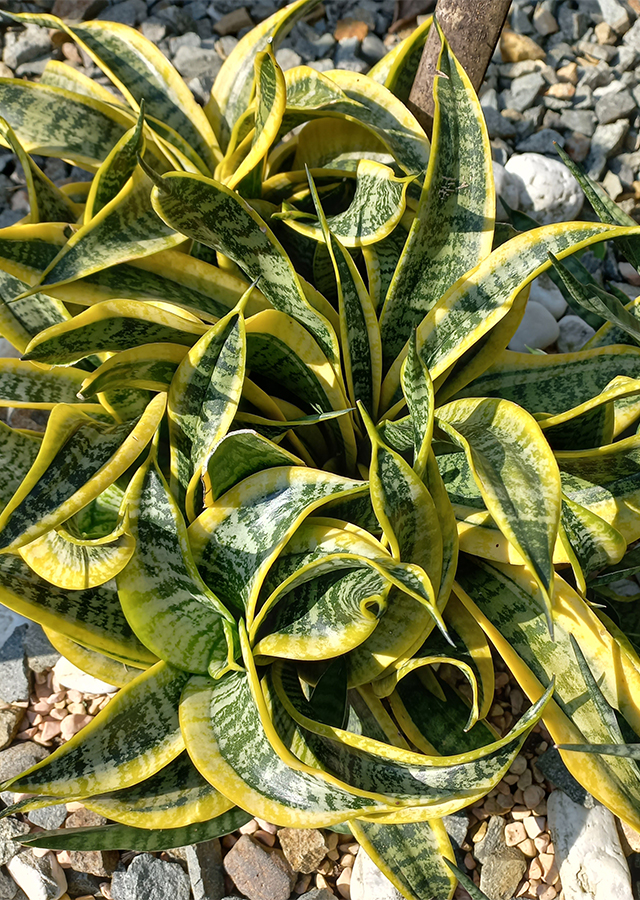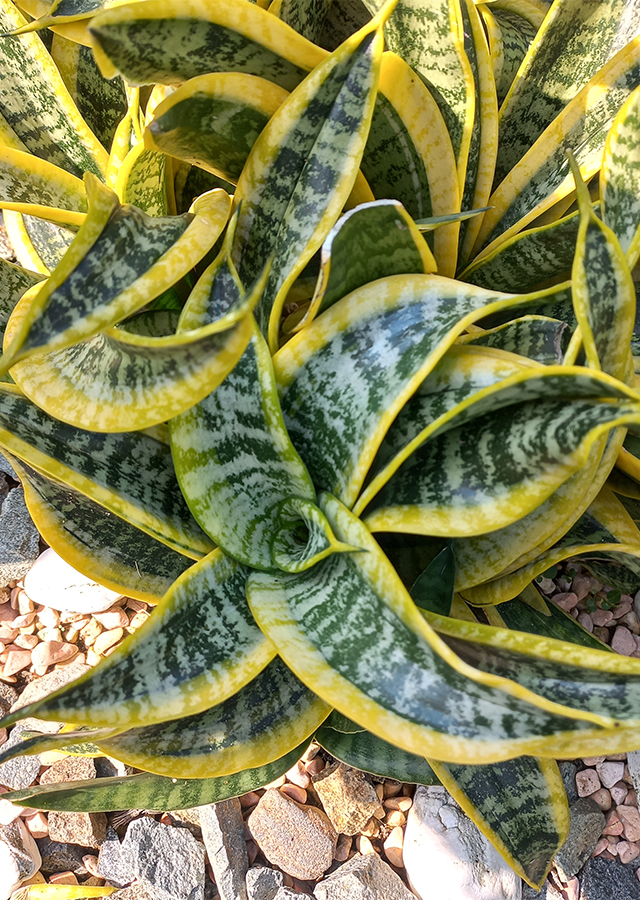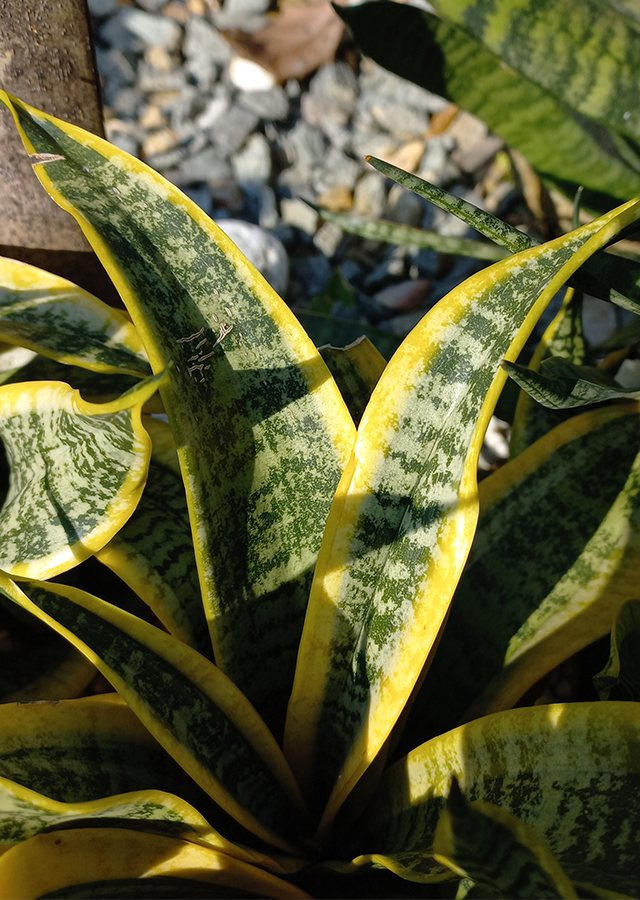Traditional Herbs from Dracaena trifasciata
diabetes
- Take one leaf of mother-in-law's tongue, wash it thoroughly and cut it into pieces.
- Boil it in 3 glasses of water until only one glass remains.
- Let it sit until warm/cool.
- Strain then drink.
medicine_hemorrhoids
- Take one dried leaf.
- Boil with\u00a03 glasses of water until one glass remains.
- Strain the boiled product and drink while warm.\u00a0
What is Dracaena trifasciata Looks like??



Parts of Dracaena trifasciata that could be used
- Leaves
- Rhizomes
Dracaena trifasciata Distribution
Mother-in-law's tongue originates from tropical Africa and has been introduced to America, Asia, Australia, and the Pacific Islands. This plant is an economically important species used as an ornamental and fiber plant in tropical and subtropical areas. More than 20 cultivars are commercialized in nurseries and the landscape trade primarily for their colorful, mottled leaves and wide and attractive leaf shape variations. Generally grown as a potted plant that is kept indoors because mother-in-law's tongue is considered one of the most efficient plants for cleaning the air by absorbing pollutants or removing toxins such as carbon dioxide, benzene, formaldehyde and trichloroethylene that are in the room. Mother-in-law's tongue plants are very long-lived and can survive for more than 50 years. Apart from being an ornamental plant, mother-in-law's tongue is a source of fiber which can be used to make ropes, mats and other raw materials for the craft industry. Traditionally, mother-in-law's tongue has also been used by African and Southeast Asian communities as a medicinal plant. Likewise in Sri Lanka, mother-in-law's tongue rhizome can be used as a traditional medicine to treat coughs and colds. Currently, the leaf extract has been used in commercial cosmetic preparations as a skin conditioner.Agroecology of Dracaena trifasciata
Mother-in-law's tongue can be found growing in tropical, subtropical and warm climates in a variety of light conditions ranging from open areas in full sun to shaded areas under the forest canopy. This species is a common weed on roadsides, abandoned gardens, waste areas, disturbed sites, coastal forests, secondary wet forests, mesic forests, and dry forests. Found at an altitude of between 500-1,200 m above sea level. Its growth prefers areas with average annual rainfall in the range of 500-1,000 mm, and sandy, fertile, well-drained soil structure, and soil acidity (pH) between 6-7, but is tolerant of low pH soil (acid). ) as well as soil with a high pH (alkaline) as well as soil with a low nutrient content. In addition, this species is also tolerant of drought and heat.
Morphology of Dracaena trifasciata
- The fibrous roots, white in color, have rhizomes that spread below and can also be above the surface of the soil.
- The stem is covered with stiff, long and thick leaves so it is considered a pseudo-stem. The stem is pale white and densely fibrous .
- Leaves form a basal rosette, the number of leaves in each rosette is around 4\u20136 leaves that cross each other in position, linear-lanceolate inverted (oblonceolate), thick, erect, stiff, juicy, surface smooth, long sword-shaped, and various motifs with grayish white transverse markings, the adaxial surface of the leaves is generally greenish white in color, has irregular horizontal lines which are dark green.
- Flowers are stalked, found in panicles. which grows upright from the base of the stem, solitary or in groups of 2-3, white or greenish white. Gives off a fragrant aroma, especially at night. Pistils and pollen are not in one flower flowers.
- Berries, fleshy, subglobose to oval-elliptical, bright orange-red in color.
- Seeds are single, the outermost part of the seeds is a thick skin. However, the process of seed formation very rarely occurs naturally.
Cultivation of Dracaena trifasciata
- Generative (seed) and vegetative propagation (leaf segment cuttings and rhizomes).
- Leaf segments and rhizomes are easy to grow and can grow quickly to form dense, almost impenetrable thickets. However, seed propagation is rare, because the location of the stigma and pollen are not in the same flower bud, so pollination is usually done with the help of human hands.
Dracaena trifasciata, more details :
Chemical Content of Dracaena trifasciataSapogenins, alkaloids, flavonoids, saponins, tannins, phenols, steroids, glycosides, triterpenes.
Benefits of Dracaena trifasciata
Treating wounds and snake bites, boils, coughs, colds, bronchitis, traumatic wounds, ringworm, scabies, fungus, diabetes, hemorrhoid medicine. Has anti-inflammatory activity.
Simplisia of Dracaena trifasciata
- Prepare enough mother-in-law's tongue leaves then wash them with clean water.
- After they are clean, drain them so that the remaining washing water is wasted.
- Chop them to a width of 1.5 cm so that drying takes place more quickly.
- Dry them in the wind -air in a place protected from sunlight.
- Blend the dry leaves until they become powder then sift them with a 60 mesh sieve.
- Store in a clean, airtight container.
Another Facts for Dracaena trifasciata :
Synonym of Dracaena trifasciataSansevieria trifasciata Prain, Sansevieria aureovariegata Mottet, Sansevieria laurentii De Wild.
Habitus of Dracaena trifasciata
Succulents. Annual succulent, up to 90 cm high
Habitat of Dracaena trifasciata
- Forest", "Coastal", "Roadside", "Shrub Area", "Grassland", "Land
No comments:
Post a Comment